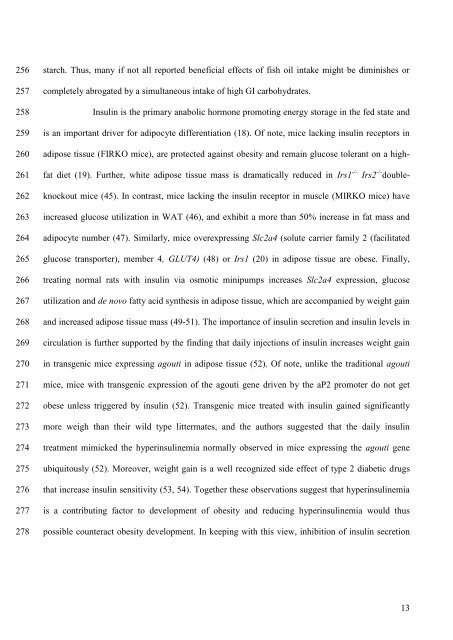The obesogenic effects of polyunsaturated fatty acids are dependent ...
The obesogenic effects of polyunsaturated fatty acids are dependent ...
The obesogenic effects of polyunsaturated fatty acids are dependent ...
Create successful ePaper yourself
Turn your PDF publications into a flip-book with our unique Google optimized e-Paper software.
256<br />
257<br />
258<br />
259<br />
260<br />
261<br />
262<br />
263<br />
264<br />
265<br />
266<br />
267<br />
268<br />
269<br />
270<br />
271<br />
272<br />
273<br />
274<br />
275<br />
276<br />
277<br />
278<br />
starch. Thus, many if not all reported beneficial <strong>effects</strong> <strong>of</strong> fish oil intake might be diminishes or<br />
completely abrogated by a simultaneous intake <strong>of</strong> high GI carbohydrates.<br />
Insulin is the primary anabolic hormone promoting energy storage in the fed state and<br />
is an important driver for adipocyte differentiation (18). Of note, mice lacking insulin receptors in<br />
adipose tissue (FIRKO mice), <strong>are</strong> protected against obesity and remain glucose tolerant on a highfat<br />
diet (19). Further, white adipose tissue mass is dramatically reduced in Irs1 -/- Irs2 -/- doubleknockout<br />
mice (45). In contrast, mice lacking the insulin receptor in muscle (MIRKO mice) have<br />
increased glucose utilization in WAT (46), and exhibit a more than 50% increase in fat mass and<br />
adipocyte number (47). Similarly, mice overexpressing Slc2a4 (solute carrier family 2 (facilitated<br />
glucose transporter), member 4, GLUT4) (48) or Irs1 (20) in adipose tissue <strong>are</strong> obese. Finally,<br />
treating normal rats with insulin via osmotic minipumps increases Slc2a4 expression, glucose<br />
utilization and de novo <strong>fatty</strong> acid synthesis in adipose tissue, which <strong>are</strong> accompanied by weight gain<br />
and increased adipose tissue mass (49-51). <strong>The</strong> importance <strong>of</strong> insulin secretion and insulin levels in<br />
circulation is further supported by the finding that daily injections <strong>of</strong> insulin increases weight gain<br />
in transgenic mice expressing agouti in adipose tissue (52). Of note, unlike the traditional agouti<br />
mice, mice with transgenic expression <strong>of</strong> the agouti gene driven by the aP2 promoter do not get<br />
obese unless triggered by insulin (52). Transgenic mice treated with insulin gained significantly<br />
more weigh than their wild type littermates, and the authors suggested that the daily insulin<br />
treatment mimicked the hyperinsulinemia normally observed in mice expressing the agouti gene<br />
ubiquitously (52). Moreover, weight gain is a well recognized side effect <strong>of</strong> type 2 diabetic drugs<br />
that increase insulin sensitivity (53, 54). Together these observations suggest that hyperinsulinemia<br />
is a contributing factor to development <strong>of</strong> obesity and reducing hyperinsulinemia would thus<br />
possible counteract obesity development. In keeping with this view, inhibition <strong>of</strong> insulin secretion<br />
13
















